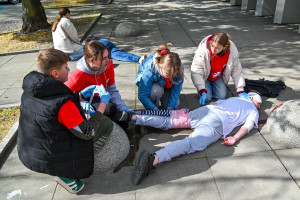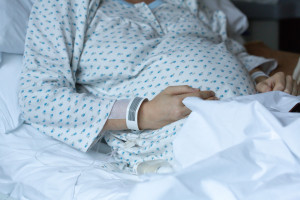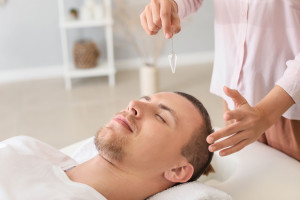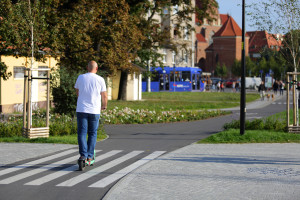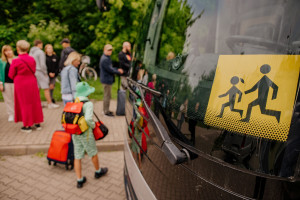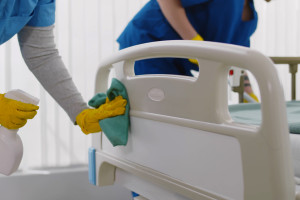A child's allergy changes the life of the entire family. A special team in the Sejm examines the challenges.

- A child's allergy is a challenge for the entire family. Desensitization is an option, which also protects against the allergic march.
- The Parliamentary Group for Allergic Diseases addressed the problem of allergies in children and the impact on the life of the entire family at its last meeting (9 July).
- The discussion included the situation of the youngest patients with allergic diseases and the impact of year-round allergies, e.g. to house dust mites, and seasonal allergies on the functioning and life of the family.
- Experts and patient representatives also raised the issue of access to desensitization
On July 9, a meeting of the parliamentary group on allergic diseases was held. The group's chair, MP Maja Nowak, thanked the experts and representatives of foundations working on behalf of allergy patients for their involvement.
- (...) I see many people here who have been with us from the very beginning, at every meeting, and I have a great feeling that it is thanks to you, your presence, knowledge, wisdom and the work you choose, that many topics have moved significantly forward - assessed Maja Nowak.
"Every parent who has a child with allergies knows that this has a huge impact on the life of not only the child but also the entire family. The biggest problem is inhalant allergens, as they are the most difficult to eliminate . These include allergies to house dust mites, pollen, and grasses," the team leader said at the beginning.
She added that children suffering from inhalant allergies experience not only persistent symptoms such as cough, runny nose, or conjunctivitis, but also sleep problems, often due to high exposure to allergens present in bedding and mattresses, among other things.
"We also know that organizing family life in homes with a child with allergies is often a truly significant challenge, both organizationally and in terms of time and finances. In addition, of course, there are doctor visits, tests, and the search for additional equipment and specialists," she pointed out.
As she said, desensitization is also an important topic.
"I have the impression, and my personal experience tells me so, that parents of allergic children often have allergies themselves and remember desensitization treatments from their childhood, which are completely different today. These parental concerns often translate into attempts to treat their children," she pointed out, expressing hope that information from experts will help encourage the use of various new treatment methods.
Epidemiology and consequences of chronic allergyProf. Bolesław Samoliński , board member of the Polish Society of Allergology, recalled that in 2005, experts initiated a program called the Epidemiology of Allergic Diseases. The study was repeated in 2018 using the same standard in children aged 6-7, revealing a further increase in hypersensitivity to airborne allergens. This time, upper respiratory tract allergy was 28%, and lower respiratory tract allergy with bronchial asthma was over 15%.
"The population of bronchial asthma patients who require ongoing medication represents approximately 5% of the Polish population, a very high percentage. Among all inhalant allergens, the most common allergens are house dust mites (over 50% of all allergy sufferers), followed by grasses. Approximately one in four Poles is allergic to dust mites, and approximately one in five is allergic to grasses and their derivatives, as well as birch, " reported Professor Bolesław Samoliński.
As he said, the milder and moderate form is more common and affects about 70-80 percent of allergy sufferers, but the remaining 20 percent are patients with serious problems.
Prof. Samoliński pointed out that hypersensitivity to indoor allergens develops between the ages of three and seven. Here, dust mites are again the most common cause. Pollen allergies begin to develop later, depending on the duration of exposure.
In the case of polyvalent allergy, i.e. simultaneous sensitization to many allergens and multimorbidity; co-occurrence of rhinitis , conjunctivitis , bronchial asthma , indoor allergens are dominant.
Family life with an allergy sufferer- So if we were to classify patients according to the severity of the disease into mild, moderate, severe, intermittent and chronic, all severe and chronic forms unfortunately have multimorbidity, multiformity, co-occurrence of asthma and rhinitis, atopic dermatitis, hypersensitivity to both food and airborne allergens - concluded the expert.
In turn, Hubert Godziątkowski from the Polish Society of Atopic Diseases pointed out that since the previous meeting of the Team devoted to anaphylaxis issues, beneficial changes for patients have been introduced in this area: partial reimbursement of epinephrine in an injector and adding the administration of epinephrine to patients to the catalogue of first aid activities.
As he said, thanks are due primarily to those involved in these processes, including decision-makers, but also to the group's chairwoman, MP Maja Nowak, for undertaking to discuss these topics within the group.
A PTA representative presented the results of a survey conducted among parents of children with allergies, which was intended to show what their lives are like.
According to research:
- 94% of parents noticed that allergy symptoms negatively impacted their children's well-being;
- 60% believe that this impact is very large;
- 96% of families incur additional expenses related to the disease for anti-allergy medications, 80% for visits to specialists, and further expenses include the costs of various devices such as air purifiers and inhalers;
- 5% of families admitted that they had to refrain from purchasing medicines due to household budget constraints;
- 54% of respondents admitted that they do not always buy prescribed medications because they cannot afford them;
- 30% of respondents said that they buy medicines but have to give up other expenses;
- 42% of patients are treated by an allergist funded by the National Health Fund and the same number privately, while the rest are treated by a pediatrician;
- 53% of respondents wait between 3 and 6 months for an appointment;
- 35% of patients use glucocorticosteroids regularly throughout the year, which translates into side effects: weakened immunity, mood changes, skin problems, weight gain, slower growth, and nosebleeds;
- 77% of respondents stated that patients are not desensitized.
As Hubert Godziątkowski pointed out, these various data indicate that some patients are excluded from treatment options, including monthly desensitization at a facility. In the case of children, parents sometimes choose not to pursue this form of administration. Therefore, sublingual therapy , additionally for home use, would be optimal, but cost can be a barrier.
Barriers in kindergartens and schools, i.e. educational exclusionAnother aspect of exclusion due to allergies was highlighted by Anna Czarnecka of the Allergy Foundation, herself a mother of an allergy sufferer who has suffered several anaphylactic shocks. According to her, the biggest problem is the lack of systemic support and the lack of preparedness of educational institutions for the presence of children with allergies.
She shared her own experience when 27 kindergartens in Warsaw refused to accept her child due to the possible need to administer adrenaline , which resulted in a move to another city where there was a facility that accepted the little allergy sufferer.
As she said, many parents struggle with this problem and often have to give up work to provide care for their child.
Another challenge in the case of food allergies is providing adequate nutrition . Preschools are unable to do this, and some facilities refuse to accept children. In others, parents must provide their own meals, which can be difficult to store or heat at the facility.
Professor Marek Kulus , member of the main board of the PTA and chairman of the Coalition for Asthma Treatment, recalled that the Ministry of Health helped two years ago and issued an announcement about the administration of adrenaline in schools, but, as he said, cooperation with the Ministry of Education is more difficult.
Unfortunately, there has been little response from schools and little willingness to overcome this barrier. He said the PTA prepared posters and booklets with instructions on how to administer adrenaline, but only 20 schools responded to the training proposal sent to several hundred schools across Poland.
The professor emphasized that after introducing changes in the legislation regarding saving lives, strong educational efforts are needed to disseminate knowledge that "basically everyone is now obliged to administer adrenaline in life-threatening situations ."
"Stop the Allergic March." New Options for Causal TreatmentProfessor Karina Jahnz-Różyk , national consultant in the field of allergology , assessed that although a legal document regarding the administration of adrenaline has appeared, it is dead.
However, she noted progress in access to sublingual vaccines and new therapies that are being reimbursed, including in increasingly younger age groups.
She emphasized that this is very important because the younger the child, the sooner such causal treatment is applied, "the sooner we will stop the allergic march and, first of all, improve the quality of life, the symptoms of the disease, but above all, it is the prevention of asthma."
"Allergen immunotherapy is a treatment that addresses the cause, slowing down the allergic march (...)," she said. She added that sublingual therapies are becoming increasingly popular, but they also pose certain challenges and concerns about patients using these therapies abandoning allergy care.
She also noted that sublingual therapies are "quite convenient," but unfortunately they do not cover all allergens, only some of the most common ones, such as dust mites, grasses, and some trees.
She also emphasized that subcutaneous desensitization is an effective form of treatment with which doctors have good experience. She also noted that sublingual therapies offer comparable effectiveness while being safer and more convenient for the patient.
Prof. Marek Kulus also spoke about the importance of desensitization as the only method of causal treatment, as opposed to other therapies that only alleviate symptoms.
"That's why this treatment is so important, because we're getting to the root of the problem, the cause of the disease. If we start this very early, the results are much better; we're stopping the allergic march," he said.
He admitted that there are patients who, given a choice, decide on subcutaneous therapy out of fear that they will not fully comply with the recommendations of sublingual therapy, but there are also patients who give up treatment due to the high costs of sublingual therapy and do not want to use the subcutaneous method.
Dr. Witold Bartosiewicz from the Clinic of Pediatric Pneumonology and Allergology of the Medical University of Warsaw also pointed out that both methods are interchangeable.
"We should offer a choice when there are no contraindications," he argued. He added that immunotherapy's effectiveness for dust mites is up to 75%, and for grasses, over 80%. Sublingual administration is particularly important for young children. Parents of children under 12 are asking when their children will have access to subsidized immunotherapy for house dust mites.
Joanna Zawadzka, president of the Allergy Center Foundation, inquired about the reimbursement of sublingual grass allergen immunotherapy for children aged 5 to 18 starting July 1st. This is one of the questions that will be submitted in writing to the Ministry of Health after the team meeting.
Prof. Jahnz-Różyk emphasized that the team is very helpful because thanks to meetings between experts, decision-makers and patient representatives, "various matters have gained momentum."
The next team meeting will focus on medication administration in educational settings.
Copyrighted material - reprint rules are specified in the regulations .
rynekzdrowia


